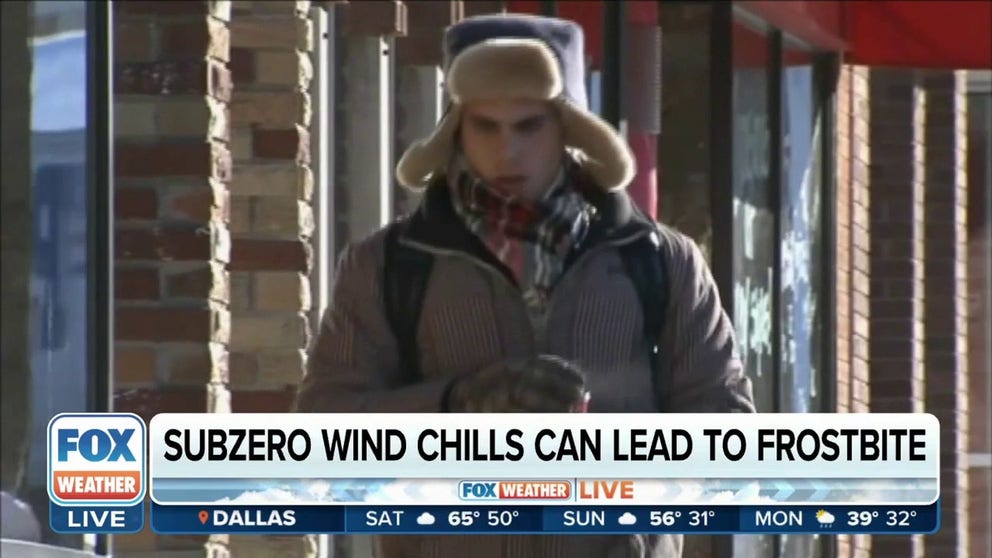What does frostbite do to your body? Here are the gory details
Frostbite, or the freezing of skin and underlying tissue, can happen very quickly. In fact, the colder the temperature, the faster frostbite can set in.
The Dangers of Frostbite
Skier Frank Fumich joins FOX Weather to discuss his experience getting frostbite twice.
It’s an injury that seems like the stuff of nightmares – ears fall off, feet lose their toes and fingertips begin to turn black, as if they touched death itself.
Rather than death, when it comes to frostbite, the culprit is the cold.
But how exactly do cold temperatures then translate into decaying body parts and lost limbs? And how cold do temperatures have to be to cause frostbite?
Even single-digit temperatures can trigger frostbite

People walk through the freezing cold in the Brooklyn borough of New York on January 31, 2019.
(ANGELA WEISS / AFP / Getty Images)
Temperatures have to be down to the single-digits for frostbite to occur, according to the Cleveland Clinic – and the lower the temperature, the faster frostbite can set it.
For example, exposure to wind chill that is -15 degrees or lower can lead to frostbite in half an hour or less.
Thoes kind of cold temperatures then cause skin and tissue cells to freeze – in other words, frostbite begins to set in.
How long it takes to get frostbite at every wind chill
Frostbite can happen in minutes and affects any exposed skin area, especially on your fingers, toes, nose and ears.
The three stages of frostbite
Frostbite occurs in three stages of progressively worsening conditions: frostnip, superficial and severe.
Frostnip is the first and mildest version of frostbite. According to the Cleveland Clinic, symptoms may not always be visible, but if they are, they might include skin that has turned red or a pale white and may begin to feel numb, tingly or cold.
Skin experiencing frostnip may be rewarmed without permanent damage.

A woman covers her self as snow falls in New York City on February 7, 2021.
(Kena Betancur/AFP / Getty Images)
With superficial frostbite, unlike frostnip, skin may feel warm. At this time, water in the skin is beginning to freeze, and the skin might swell or sting.
According to the Mayo Clinic, rewarming skin with a superficial frostbite may result in discoloration, along with swelling, stinging and burning. Within 12-36 hours, a fluid-filled blister may appear.
How to protect against frostbite as bitter cold arrives
An arctic blast is surging south toward the Northern Plains and Upper Midwest. Several states may experience dangerous wind chills that fall into the negative 30- and 40-degree marks. With those bitter temps, frost bite will be possible in as little as 15 minutes. Dr. Ivan Miller, director of emergency medicine at Westchester Medical Center, joins FOX Weather with the best ways to avoid frostbite if you have to be outside in these frigid temperatures.
FROSTBITE SURVIVOR CREATES WARM GEAR FOR THE HOMELESS
Lastly, the third and most serious form of frostbite is severe frostbite.
Severe frostbite involves damage throughout all layers of the skin and the tissues underneath. Skin becomes blue-gray or white and loses all feeling in the affected area.
According to the Mayo Clinic, joints and muscles may stop working. After rewarming, the affected area grows blisters. Plus, the tissue becomes hard and turns black as it dies.

An oil field worker got frostbite on his feet, legs and hands while working in sub-freezing temperatures on the oil fields.
(RJ Sangosti / The Denver Post / Getty Images)
How to prevent frostbite
To prevent frostbite, it is important to remain vigilant in cold weather. Stay aware of the first signs of frostbite, along with ways to properly and safely rewarm your skin without causing further damage.
The Mayo Clinic offers the following ways to dress warmly and prevent frostbite:
- Dress in loose, light, comfortable layers to help trap warm air - The first layer should be made of a synthetic material, which wicks moisture away from your body. The next layer should be insulating and preferably made of wool and fleece. The top layer should be windproof and waterproof.
- Protect your feet and toes by wearing two pairs of socks - The pair laying directly on your skin should be made of moisture-wicking fabric. On top of that layer, place a pair of wool or wool-blend socks.
- Wear boots that are waterproof and provide adequate insulation - They should cover your ankles, and they should not feel tight.
- Protect your head - Wear a heavy wool or fleece hat over your ears and head. Also cover your face with a scarf or face mask, which warms the air you breathe and helps prevent frostbite on your nose and face.
- Protect your hands by wearing insulated mittens or gloves.
If your skin does become frostbitten, the American Academy of Dermatologists Association recommends gently rewarming the affected areas, drink warm liquids and consider taking an over-the-counter pain reliever.
Also make sure not to break any blisters that may form, and seek medical attention for superficial and severe cases of frostbite.


